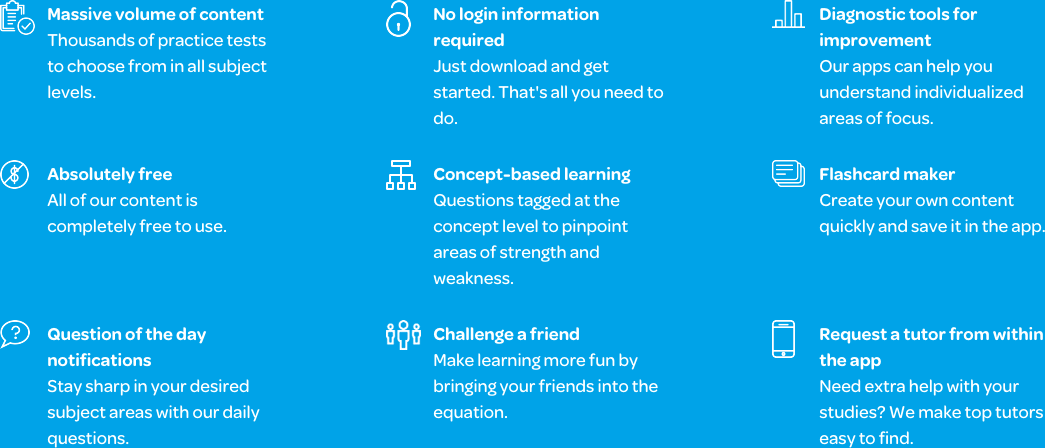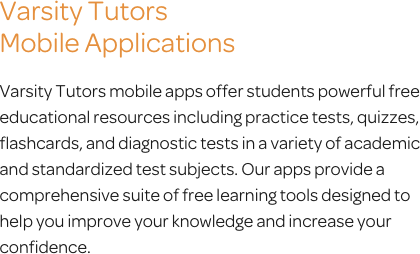The Varsity Tutors GMAT Mobile App
In order to start earning a master’s degree, you may need to take the GMAT, or Graduate Management Admission Test. Your score may be a factor in determining your acceptance into the graduate program at your chosen school.
The free Varsity Tutors GMAT Prep app is a valuable learning tool that is available from iTunes and the Google Play Store. You can take advantage of the app to review all the information you will need to know for the three-and-a-half-hour exam. The exam has four sections: Integrated Reasoning, Analytical Writing, Verbal Reasoning, and Quantitative Reasoning. You can use the free app to prepare ahead of time, rather than trying to cram all the content into one sitting.
The application has a variety of tools that can be implemented flexibly to create a versatile study guide. There are hundreds of flashcards that are available in the app’s database. Choose the concept you need to practice the most, and flip through the flashcards. In Quantitative Reasoning, you’ll see questions that revolve around problem solving and data sufficiency. On these, you may be required to solve or explain a problem involving arithmetic, geometry, or algebra. The flashcards provide detailed explanations that delve into the “why” and the “how.”
The Question of the Day feature is a valuable tool. Each day, the GMAT prep app provides a new question for each section on the GMAT. You can use these for a quick, daily assessment of your readiness. You are able to take all the time you need to solve the problem, and can see a full review of your results upon answering. You can see which concept you worked on, a full explanation of the answer, and your overall solving time in comparison to others who answered the question.
There are also several full-length practice tests available to help you assess your abilities in analysis, evaluation, and conclusions. With the concept-specific practice tests, you can dig deeper into specific topics, such as understanding mixed passages or analyzing an argument for claims and biases. The application offers a professionally-written database of practice questions to prepare you for the types of questions you’ll see on the GMAT. You will always get comprehensive explanations of all the relevant concepts.
You can take advantage of the timed tests on the GMAT app to practice completing the sections in the hour and 10 minutes you will be allotted on test day. The information each feature provides can help you identify your strengths and weaknesses so you can focus your efforts on harder concepts. You can combine the tools to create a comprehensive study guide to enter your exam with confidence, knowledge, and skill.
For many, the GMAT takes months to prepare for. You can get your study plan off to a good start by downloading the free Varsity Tutors GMAT Prep app on your Apple or Android device. Use the tools available to develop a deeper understanding of the knowledge you’ll need on the test.
66 mobile apps to choose from for your tutoring needs.

Learn More
First administered in 1953, the Graduate Management Admission Test, or GMAT, is a standardized exam that is taken by approximately 250,000 students each year. It is owned and administered by the Graduate Management Admission Council. The GMAT assesses a candidate’s reading, writing, quantitative, analytic, and verbal skills. It is intended for students who have already earned, or who are about to graduate with a bachelor’s degree. Your score may be used as a factor in business school and management program admission decisions at over 2,000 universities in the U.S. and abroad. It is the leading standardized test for MBA candidates. The test is administered several times each year in over 110 countries around the world, and you can take it once every 31 days.
The GMAT is made up of four different sections: Quantitative, Verbal, Integrated Reasoning, and Analytical Writing. In total, you will have three-and-a-half hours to complete the sections. Your score indicates your proficiency level in a variety of skills that may be used in real-world business situations. The Verbal and Quantitative sections are calculated using an algorithm, which considers three factors that can affect your score: the total number and difficulty level of the questions you answered within the allotted time, and the number of correct answers. Each of these sections are scored on a scale of 0 to 60; together, these will determine your total scaled score, which can range from 200 to 800. The Integrated Reasoning section is scored on a scale from 1 to 8, and the Analytical Writing section score ranges from 1 to 6. Neither the Integrated Reasoning nor the Analytical Writing scores will affect your total scaled score. Your scores will be valid for five years.
The first section of the GMAT is the Analytical Writing Assessment. You will be given 30 minutes in which to respond to one prompt. The primary objective of this essay is to analyze an argument. You will be asked to discuss and critique the provided argument’s reasoning and use of evidence. The Analytical Writing Assessment is scored twice: once by a computerized program that will scan your essay for structure, organization, syntax, and topical relevance, and once by a human reader. If the two scores differ by more than one point, an expert human reader will examine the discrepancy and issue a final score. Since you will only have 30 minutes in which to complete your response, you will need to have keen outlining and analytical skills. The highest-scoring responses are, of course, linguistically and stylistically superb. They also have structurally sound, thoughtfully developed arguments which are supported with examples and evidence.
Next, you will take the Integrated Reasoning section, which measures skills that are especially relevant in today’s technology-driven society. The Integrated Reasoning section is the newest section of the GMAT, and was first introduced in June of 2012. It tests skills that have been identified as important by a survey of hundreds of business management professionals. The 12 questions in this section are made up of four different question types: multi-source reasoning, table analysis, two-part analysis, and graphic interpretation. These questions will evaluate your practical skills in processing information in a variety of formats from multiple sources. On the multi-source reasoning questions, you will have to read and interpret the data from up to three different information sources to choose an answer from one of the multiple-choice options. For the table analysis questions, you will have to respond to a number of opposite-answer questions related to the data, which is provided to you in a spreadsheet-like table of information. The two-part analysis questions ask you to complete a table with the two components that solve the problem, and the graphical interpretation questions will evaluate your skills in reading graphs and graphical representations.
After the Integrated Reasoning section, you will face the GMAT’s Quantitative section, which tests your skills in information interpretation, data analysis, and quantitative reasoning and solving. You are given 75 minutes in which to answer 37 questions, and you will not be permitted to use a calculator. The testing location will provide you with laminated paper and a wipe-off pen for calculations you may want to do by hand. The Quantitative section features two types of questions: data sufficiency and problem solving. Both types of questions may ask you to use your arithmetic, algebra, or geometry skills; however, the questions will not demand an upper-level or specialized knowledge of mathematics. The data sufficiency questions are exclusive to the GMAT, and evaluate your ability to assess the data provided for a quantitative problem. You will have to decide whether the information provided is relevant, and if you have enough relevant information to successfully solve the problem. The problem-solving questions measure your quantitative reasoning and solving skills through numerical problems, graphical interpretation, and information evaluation.
The GMAT ends with the Verbal section. With 75 multiple-choice questions to be answered in 41 minutes, it is important to work quickly, yet accurately. This section will test you on your skills in critical reasoning, reading comprehension, and sentence correction. You will be asked to use your critical reasoning skills on questions that deal with crafting and evaluating arguments and plans of action. The passage-based reading comprehension questions measure your skills in understanding, analyzing, and using written information, and the sentence correction problems will ask you to replace a part of a sentence with a more grammatically and structurally correct option. These questions test your working knowledge of the standards of written English, and may touch upon word choice, sentence structure, or grammar.
If you are interested in working toward your Master of Finance, Master of Accountancy, or MBA, taking the GMAT is a great way to showcase your skills. Since scoring well on the GMAT has been statistically proven to predict your success in a business school program, you’ll want to create a consistent, focused GMAT review plan. By brushing up on your quantitative reasoning, analytical, and verbal skills, you’ll be prepared to put your best foot forward on test day.




